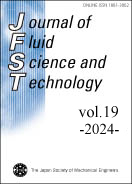19 巻, 2 号
選択された号の論文の17件中1~17を表示しています
- |<
- <
- 1
- >
- >|
ASME-JSME-KSME Joint Fluids Engineering Conference 2023
-
2024 年 19 巻 2 号 p. JFST0005
発行日: 2024年
公開日: 2024/03/28
PDF形式でダウンロード (697K)
Paper
-
2024 年 19 巻 2 号 p. JFST0006
発行日: 2024年
公開日: 2024/03/28
PDF形式でダウンロード (3841K) -
2024 年 19 巻 2 号 p. JFST0007
発行日: 2024年
公開日: 2024/03/28
PDF形式でダウンロード (1834K) -
2024 年 19 巻 2 号 p. JFST0008
発行日: 2024年
公開日: 2024/03/28
PDF形式でダウンロード (4500K) -
2024 年 19 巻 2 号 p. JFST0009
発行日: 2024年
公開日: 2024/03/28
PDF形式でダウンロード (1656K) -
2024 年 19 巻 2 号 p. JFST0010
発行日: 2024年
公開日: 2024/03/28
PDF形式でダウンロード (2296K) -
2024 年 19 巻 2 号 p. JFST0011
発行日: 2024年
公開日: 2024/03/28
PDF形式でダウンロード (2140K) -
2024 年 19 巻 2 号 p. JFST0012
発行日: 2024年
公開日: 2024/03/28
PDF形式でダウンロード (5123K) -
2024 年 19 巻 2 号 p. JFST0013
発行日: 2024年
公開日: 2024/03/28
PDF形式でダウンロード (1959K) -
2024 年 19 巻 2 号 p. JFST0014
発行日: 2024年
公開日: 2024/03/28
PDF形式でダウンロード (3659K) -
2024 年 19 巻 2 号 p. JFST0015
発行日: 2024年
公開日: 2024/03/28
PDF形式でダウンロード (2439K) -
2024 年 19 巻 2 号 p. JFST0016
発行日: 2024年
公開日: 2024/03/28
PDF形式でダウンロード (1613K) -
2024 年 19 巻 2 号 p. JFST0017
発行日: 2024年
公開日: 2024/03/28
PDF形式でダウンロード (1390K) -
2024 年 19 巻 2 号 p. JFST0018
発行日: 2024年
公開日: 2024/03/28
PDF形式でダウンロード (2737K) -
2024 年 19 巻 2 号 p. JFST0019
発行日: 2024年
公開日: 2024/03/28
PDF形式でダウンロード (2283K) -
2024 年 19 巻 2 号 p. JFST0020
発行日: 2024年
公開日: 2024/03/28
PDF形式でダウンロード (8828K) -
2024 年 19 巻 2 号 p. JFST0021
発行日: 2024年
公開日: 2024/03/28
PDF形式でダウンロード (2305K)
- |<
- <
- 1
- >
- >|
